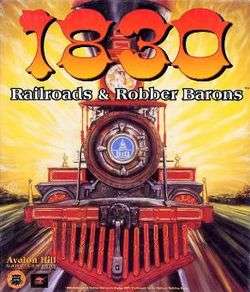1830: Railroads & Robber Barons
| 1830: Railroads & Robber Barons | |
|---|---|
|
Cover art | |
| Developer(s) | Simtex |
| Publisher(s) | Avalon Hill |
| Platform(s) | DOS |
| Release date(s) |
‹See Tfd›
|
| Mode(s) | Single-player, multiplayer |
1830: Railroads & Robber Barons is a computer game developed by SimTex and published by Avalon Hill in 1995 for IBM/DOS.
Gameplay
1830: Railroads & Robber Barons is a multi-player computer game adaptation of the Avalon Hill board game, 1830. With default settings, the game is a very strict implementation of the board game. Starting with a relatively small amount of seed capital, players purchase shares in eight different railroad companies; ownership of a majority of a company's shares makes a player its president, letting them dictate how the company lays track on a map of the northeastern US, builds stations, buys trains, and runs them on routes to generate revenue. The game ends when the players have collectively earned a certain amount of money ("breaking the bank") or when a player or computer opponent goes bankrupt, at which point a player wins by having the highest total of stock valuation plus cash on hand. As in the board game, tactics such as looting companies of their assets, using buy/sell patterns to manipulate the stock market, and dumping unprofitable companies on other shareholders are prominent aspects of play.
The game has many options to alter game play, both minor (such as modifying the way trains become obsolete, or providing variable instead of fixed dividends per share) and major (adding a ninth railroad). Some variants, such as allowing random game maps or an unlimited number of the different types of track segment, are unique to the computer version, as they would be difficult to impossible to realize with a physical game.
The game can be played by a single player against one to five computer opponents, or multiplayer with "hot seat" play. There is no built-in facility for play over network, but modern players have done so by running a hot seat multiplayer game in a virtual desktop. Solo mode has four levels of computer opponent difficulty; at higher levels, the computer opponents collude so as to try to have any one of them defeat the player rather than having each maximize its own position (behavior that would not usually arise in a game among human players).
Reception
The game was reviewed in 1995 in Dragon #219 by Jay & Dee in the "Eye of the Monitor" column. Jay gave the game 3½ out of 5 stars, while Dee gave the game 4 stars.[1]
References
- ↑ Jay & Dee (July 1995). "Eye of the Monitor". Dragon (219): 57–60, 65–66.
